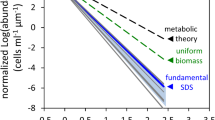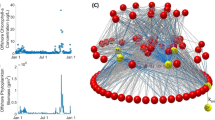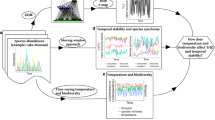Abstract
Complex dynamics are often shown by simple ecological models1,2 and have been clearly demonstrated in laboratory3,4 and natural systems5,6,7,8,9. Yet many classes of theoretically possible dynamics are still poorly documented in nature. Here we study long-term time-series data of a midge, Tanytarsus gracilentus (Diptera: Chironomidae), in Lake Myvatn, Iceland. The midge undergoes density fluctuations of almost six orders of magnitude. Rather than regular cycles, however, these fluctuations have irregular periods of 4–7 years, indicating complex dynamics. We fit three consumer–resource models capable of qualitatively distinct dynamics to the data. Of these, the best-fitting model shows alternative dynamical states in the absence of environmental variability; depending on the initial midge densities, the model shows either fluctuations around a fixed point or high-amplitude cycles. This explains the observed complex population dynamics: high-amplitude but irregular fluctuations occur because stochastic variability causes the dynamics to switch between domains of attraction to the alternative states. In the model, the amplitude of fluctuations depends strongly on minute resource subsidies into the midge habitat. These resource subsidies may be sensitive to human-caused changes in the hydrology of the lake, with human impacts such as dredging leading to higher-amplitude fluctuations. Tanytarsus gracilentus is a key component of the Myvatn ecosystem, representing two-thirds of the secondary productivity of the lake10 and providing vital food resources to fish and to breeding bird populations11,12. Therefore the high-amplitude, irregular fluctuations in midge densities generated by alternative dynamical states dominate much of the ecology of the lake.
This is a preview of subscription content, access via your institution
Access options
Subscribe to this journal
Receive 51 print issues and online access
$199.00 per year
only $3.90 per issue
Buy this article
- Purchase on Springer Link
- Instant access to full article PDF
Prices may be subject to local taxes which are calculated during checkout



Similar content being viewed by others
References
May, R. M. Simple mathematical models with very complicated dynamics. Nature 261, 459–467 (1976)
Hastings, A., Hom, C. L., Ellner, S., Turchin, P. & Godfray, H. C. J. Chaos in ecology: is Mother Nature a strange attractor? Annu. Rev. Ecol. Syst. 34, 1–33 (1993)
Dennis, B., Desharnais, R. A., Cushing, J. M., Henson, S. M. & Costantino, R. F. Estimating chaos and complex dynamics in an insect population. Ecol. Monogr. 71, 277–303 (2001)
Becks, L., Hilker, F. M., Malchow, H., Jurgens, K. & Arndt, H. Experimental demonstration of chaos in a microbial food web. Nature 435, 1226–1229 (2005)
Bjornstad, O. N. & Grenfell, B. T. Noisy clockwork: Time series analysis of population fluctuations in animals. Science 293, 638–643 (2001)
Dwyer, G., Dushoff, J. & Yee, S. H. The combined effects of pathogens and predators on insect outbreaks. Nature 430, 341–345 (2004)
Turchin, P. Complex Population Dynamics: a Theoretical/Empirical Synthesis (Princeton Univ. Press, Princeton, NJ, 2003)
Hanski, I., Turchin, P., Korpimaki, E. & Henttonen, H. Population oscillations of boreal rodents—regulation by mustelid predators leads to chaos. Nature 364, 232–235 (1993)
Scheffer, M., Carpenter, S., Foley, J. A., Folke, C. & Walker, B. Catastrophic shifts in ecosystems. Nature 413, 591–596 (2001)
Lindegaard, C. & Jónasson, P. M. Abundance, population dynamics and production of zoobenthos in Lake My´vatn, Iceland. Oikos 32, 202–227 (1979)
Gudbergsson, G. Arctic charr in Lake Myvatn: the centennial catch record in the light of recent stock estimates. Aquatic Ecol. 38, 271–284 (2004)
Gardarsson, A. & Einarsson, A. Resource limitation of diving ducks at Myvatn: Food limits production. Aquatic Ecol. 38, 285–295 (2004)
May, R. M. Thresholds and breakpoints in ecosystems with a multiplicity of stable states. Nature 269, 471–477 (1977)
Noy-Meir, I. Stability of grazing systems: an application of predator–prey graphs. J. Ecol. 63, 459–481 (1975)
Scheffer, M., Hosper, S. H., Meijer, M.-L., Moss, B. & Jeppesen, E. Alternative equilibria in shallow lakes. Trends Ecol. Evol. 8, 275–279 (1993)
Persson, L. et al. Culling prey promotes predator recovery—alternative states in a whole-lake experiment. Science 316, 1743–1746 (2007)
Carpenter, S. R. Regime Shifts in Lake Ecosystems: Patterns and Variation (International Ecology Inst., Oldendorf/Luhe, Germany, 2003)
Henson, S. M., Costantino, R. F., Desharnais, R. A., Cushing, J. M. & Dennis, B. Basins of attraction: population dynamics with two stable 4-cycles. Oikos 98, 17–24 (2002)
Ives, A. R., Gross, K. & Jansen, V. A. A. Periodic mortality events in predator–prey systems. Ecology 81, 3330–3340 (2000)
King, A. A. & Schaffer, W. M. The rainbow bridge: Hamiltonian limits and resonances in predator–prey models. J. Math. Biol. 39, 439–469 (1999)
Jansen, V. A. A. & Sabelis, M. W. Outbreaks of colony-forming pests in tri-trophic systems: consequences for pest control and the evolution of pesticide resistance. Oikos 74, 172–176 (1995)
Klebanoff, A. & Hastings, A. Chaos in three species food chains. J. Math. Biol. 32, 427–451 (1994)
Kendall, B. E. et al. Why do populations cycle? A synthesis of statistical and mechanistic modeling approaches. Ecology 80, 1789–1805 (1999)
Ingvason, H. R., Olafsson, J. S. & Gardarsson, A. Food selection of Tanytarsus gracilentus larvae (Diptera: Chironomidae): an analysis of instars and cohorts. Aquatic Ecol. 38, 231–237 (2004)
Einarsson, A., Gardarsson, A., Gislason, G. M. & Ives, A. R. Consumer–resource interactions and cyclic population dynamics of Tanytarsus gracilentus (Diptera: Chironomidae). J. Anim. Ecol. 71, 832–845 (2002)
Gardarsson, A. et al. Population fluctuations of chironomid and simuliid Diptera at Myvatn in 1977–1996. Aquatic Ecol. 38, 209–217 (2004)
Kjaran, S. P., Hólm, S. L. & Myer, E. M. Lake circulation and sediment transport in Lake Myvatn. Aquatic Ecol. 38, 145–162 (2004)
Harvey, A. C. Forecasting, Structural Time Series Models and the Kalman Filter (Cambridge Univ. Press, Cambridge, 1989)
McGovern, T. H., Perdikaris, S., Einarsson, A´. & Sidell, J. Coastal connections, local fishing, and sustainable egg harvesting: patterns of Viking Age inland wild resource use in My´vatn district, Northern Iceland. Environ. Archaeol. 11, 187–205 (2006)
Ives, A. R., Dennis, B., Cottingham, K. L. & Carpenter, S. R. Estimating community stability and ecological interactions from time-series data. Ecol. Monogr. 73, 301–330 (2003)
Acknowledgements
We thank K. C. Abbott, M. Duffy, K. J. Forbes, R. T. Gilman, J. P. Harmon and members of Zoo/Ent 540, Theoretical Ecology, University of Wisconsin – Madison, for comments on the manuscript. V.A.A.J. thanks R. A. Jansen-Spence for the time to do this research. This work was funded in part by National Science Foundation grants to A.R.I., and grants from the Icelandic Research Council and the University of Iceland Research Fund to A.E. and A.G.
Author Contributions A.E. and A.G. oversaw the data collection and are responsible for the long-term study on midge dynamics in Myvatn. A.E. and A.R.I. conceived the midge–algae–detritus model, and A.R.I. performed statistical analyses. V.A.A.J. and A.R.I. performed the mathematical analyses of the midge–algae–detritus model.
Author information
Authors and Affiliations
Corresponding author
Supplementary information
Supplementary Information
The file contains Supplementary Notes, Supplementary Figures S1-S10 with Legends and Supplementary Methods and Supplementary Table S1. (PDF 480 kb)
Rights and permissions
About this article
Cite this article
Ives, A., Einarsson, Á., Jansen, V. et al. High-amplitude fluctuations and alternative dynamical states of midges in Lake Myvatn. Nature 452, 84–87 (2008). https://doi.org/10.1038/nature06610
Received:
Accepted:
Issue Date:
DOI: https://doi.org/10.1038/nature06610
This article is cited by
-
Detecting alternative attractors in ecosystem dynamics
Communications Biology (2021)
-
No net insect abundance and diversity declines across US Long Term Ecological Research sites
Nature Ecology & Evolution (2020)
-
Modeling a cross-ecosystem subsidy: forest songbird response to emergent aquatic insects
Landscape Ecology (2020)
-
Circumpolar terrestrial arthropod monitoring: A review of ongoing activities, opportunities and challenges, with a focus on spiders
Ambio (2020)
-
Responses of orb-weaving spider aggregations to spatiotemporal variation in lake-to-land subsidies at Lake Mývatn, Iceland
Polar Biology (2018)
Comments
By submitting a comment you agree to abide by our Terms and Community Guidelines. If you find something abusive or that does not comply with our terms or guidelines please flag it as inappropriate.



